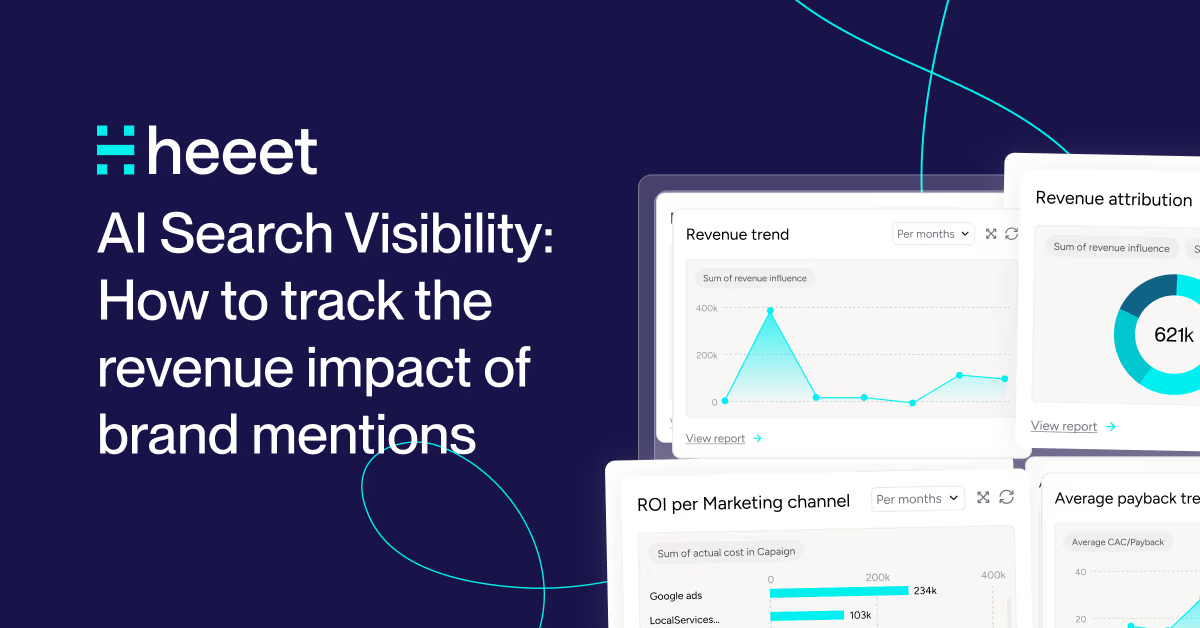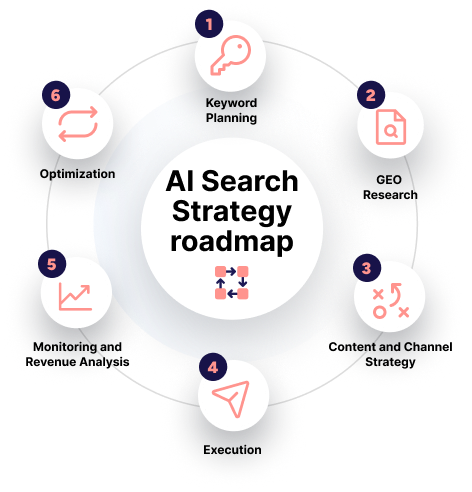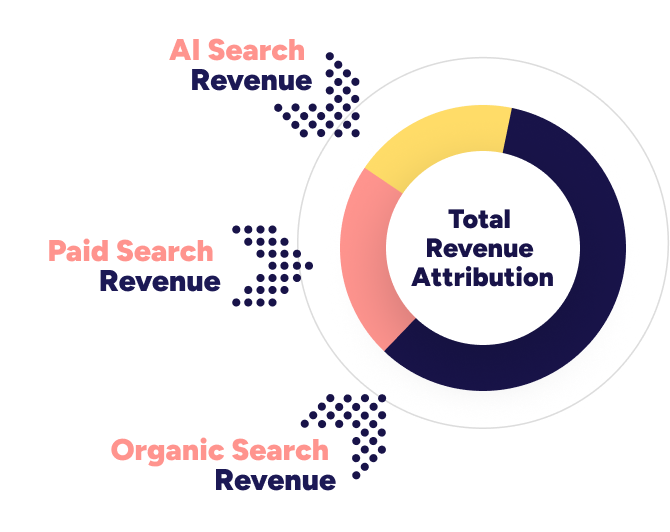Read time :
AI Search Visibility: How to track the revenue impact of brand mentions
Learn to track and measure AI search ROI with proven GEO strategies. Complete guide to LLM mentions attribution, revenue tracking tools, and conversion optimization for B2B success.


Large Language Models are changing how customers discover brands. According to Forrester, in less than two years, 89% of B2B buyers have adopted AI search, naming it as a top source for research in every phase of the purchase journey. This run-through provides a breakdown of the current context and a how-to guide, enabling you to track, measure, optimize, and reveal the invisible revenue impact of LLM mentions by employing Generative Engine Optimization (GEO).
Why Are LLMs Becoming an Invisible Revenue Channel?
Prospects are making their favorite LLM equipped with deep reasoning features and web search do more of the heavy lifting when it comes to identifying and qualifying products and services.
The context-aware answers provided by ChatGPT, Google's Gemini, Claude, and Perplexity AI give users the coherent details and comparisons they need, eliminating the need for link clicking and form filling for gated content.
Your prospects are now making quicker decisions, and consequently, the buyer journey is accelerating.
Contrary to traditional search that would show lead sources and traffic generated from search, AI search users are creating an influx of invisible revenue from direct traffic for brands getting referenced in overviews that provide:
- Direct brand citations: Unlike traditional search engines that return link lists, LLMs generate responses that often cite sources or brands directly in the output.
- Zero-click interactions: Users receive answers without needing to click through to websites, making brand mentions more valuable than traditional website traffic.
- Early buyer journey influence: LLMs impact user decisions at the awareness and consideration stages.
- Conversational search behavior: Users ask more specific, intent-driven questions, and get answers to questions they'd typically ask on Reddit.
AI search gives marketing teams three new tasks to seize the opportunity. See how their brand is performing in AI search. Secondly, optimize their website, content, and brand authority to earn more AI visibility. Finally, measure the revenue influence.
Current LLM Usage Statistics (2025)
Everyone in the buying committee is using AI search.
You don't need to think twice to realize that user adoption is on a steep incline:
- ChatGPT processes 2.5 billion queries daily
- Perplexity sees 30M+ daily queries as of June 2025
- Heeet's numbers show that 90% of GEO visitors are first-time site visitors when they do click through AI-search
The numbers speak volumes and are giving sales and marketing teams the wide-eyed "oh, we need to move quickly" reaction. That's why B2B teams are tapping on the shoulder of the SEO team and hoping they have a plan.
The Strategic Shift: How LLMs Are Replacing Traditional SEO for Brand Discovery

The good thing is your in-house SEO expert or agency is well aware of the opportunity AI search presents and its importance in the buyer's journey.
Generative Engine Optimization (GEO) represents a landmark shift, where, in some cases, such as brand discovery, AI visibility matters more than traditional search engine rankings. Herein lies the opportunity for brands willing to adapt and prioritize GEO.
Why GEO is starting to outperform Traditional SEO for brands
It's currently the wild west, and the GEO gold rush is in high gear. Brands with a keen eye on getting ahead of the pack will enjoy a host of competitive advantages, such as:
- Moving quickly in a less competitive landscape: Fewer brands are optimizing for AI citations, making it a priority and getting your brand referenced before a competitor is easier than it has ever been.
- Faster optimization cycles: Ranking #1 in Google is great, but what matters in AI-search is being cited and, of course, the sentiment used when referring to your brand. This is where Reddit threads, Quora, and other communities, where product comparisons and discussions come into play.
- Higher-intent traffic from top-of-funnel buyers: Users are asking specific questions regarding products and services they're searching for, thus indicating high purchase intent.
- Zero-click influence: Despite the lack of a direct website visit, you can still gain brand awareness and influence behavior without requiring website visits or ad dollars.
GEO vs. SEO: Revenue Performance Analysis
Early GEO performance data from Heeet clients has shown stellar conversion results. Leads generated from AI search had a 68% higher conversion rate and a 141% higher close rate, while consuming 17% less content, and resulted in a revenue outcome 3x faster compared to paid search traffic.
The higher conversion rates are driven by traffic redirected from LLMs and do not account for direct traffic from zero-click influence.
Another key statistic to note about the GEO visitors is that 90% of them are first-time site visitors, so whether they're clicking on a link from ChatGPT results or typing your URL manually, you're getting more pre-qualified leads on your site.
Why GEO Leads Convert Better
There's a trifecta of elements that contribute to the quicker and higher conversion rates of GEO leads. LLMs qualify leads before they reach your site, accelerating the pipeline by providing in-depth answers or recommendations, and in many cases, for first-time researchers or visitors.
Pre-qualification by AI
The AI-generated responses are educating prospects about relevant solutions and use cases. This creates the type of lead that arrives on your site with higher intent and a clearer understanding of their needs.
Accelerated Sales Cycles
GEO traffic typically requires fewer touchpoints before conversion because, as mentioned above, they've already been educated by their LLM and are less likely to feel the need to read numerous blog articles or scan other informative channels to make a decision. Not only are these leads more knowledgeable, but they most likely were aided by a comparative analysis that an LLM provided to help them make a decision.
First-Time Visitor Advantage
As seen among Heeet clients, 90% of GEO visitors are new to your brand. That's a fresh pipeline opportunity that marketing is more than happy to hand over to sales. There's also a higher likelihood that competitors haven't influenced these visitors.
Building Comprehensive GEO Performance Reports You Can Link to Revenue

At this stage, your content is optimized and integrated, but how do you know if it's working, and what content is generating revenue? AI search extends beyond clicks and traffic. Defining new metrics that reflect visibility in LLMs is essential.
Effective GEO reporting requires combining multiple data sources to create a complete picture of how AI-generated traffic impacts your revenue pipeline. The most valuable insights come from correlating four key tracking fields with your business outcomes.
Essential Reporting Metrics
1. LLM Platform Performance
There are three core KPIs that every brand should start measuring in the AI search era that you should all be analyzing at the platform level so you can see the difference in performance across LLMs:
- LLM Share of voice: how often your brand appears in AI-generated answers relative to competitors. Brands in the top quartile for web mentions receive 10 times more AI citations than those in the second quartile, according to Ahrefs.
- AI Generated Impressions: Count of times your content appears in AI answers or overviews, regardless of clicks. Even without direct traffic, these impressions build awareness similar to ad views.
- Referral Traffic: Visits coming directly from AI tools like ChatGPT, Bing Chat, and Perplexity. Often appears as "ChatGPT/Not set" in analytics. You'll see lower volumes, but typically higher quality traffic.
And a bonus metric that shouldn't be neglected:
- Brand sentiment: how your brand is being mentioned is just as crucial as being mentioned, if not more. If you're being positioned as a suboptimal option or not being recommended, you may find a gap between reality and what LLMs are suggesting.
Looking at conversion cost metrics, here are a few that should be on your dashboard:
- Conversion Rate by Platform: Identify which LLMs send the highest-quality leads
- Revenue per Platform: Calculate actual revenue generated by each AI platform
- Cost per Acquisition: Compare GEO acquisition costs to other channels
2. Content Performance Analysis
Tying traffic to exact content pieces is your guiding light on what works and what content needs improvement and to be refreshed. Here are a few metrics to follow:
- Most Referenced Content: Identify pages that receive the most AI citations
- Conversion by Landing Page: Track which content converts GEO traffic best
- Content Optimization Opportunities: Find high-traffic, low-conversion pages
- Topic Performance: Analyze which subject areas generate the most qualified leads
3. Sales Velocity Metrics
Finally, getting the rundown on how your GEO strategy is creating sales opportunities is where you can justify the initiative:
- Time to First Conversion: Average time from first visit to form submission
- Sales Cycle Length: Time from lead to closed deal for GEO traffic
- Pipeline Velocity: How quickly GEO leads move through sales stages
- Multi-touch Attribution: Credit GEO appropriately in complex buyer journeys
Highlighting Your Revenue KPIs
This is where the hard work pays off, and you let the dashboard do the talking internally. There's no better way to gain buy-in across the organization than by showing them the revenue impact. Here are some revenue metrics that we're prioritizing at Heeet and are closely working with clients to include in their setup.
Revenue Metrics:
- Total revenue attributed to GEO traffic
- Average deal size for GEO-sourced opportunities
- Customer lifetime value for AI-acquired customers
- Return on investment for GEO optimization efforts
Operational Metrics:
- GEO traffic growth rate month-over-month
- Lead quality score for AI-sourced prospects
- Sales team satisfaction with GEO lead quality
- Time savings in the prospect qualification process
Dashboard Creation Guide
Nobody wants to drown in KPIs that aren't relevant. That's where dedicated dashboards come into play. Here's what each team should be keeping an eye on.
Executive-Level Dashboard Components:
- Revenue contribution from GEO vs. other channels
- Growth trends for AI-generated traffic
- ROI comparison across acquisition channels
- Forecasted impact of GEO optimization investments
Marketing Team Dashboard Components:
- Content performance by AI citation frequency
- Keyword opportunities for GEO optimization
- Competitive analysis of AI mention share
- Campaign performance optimization recommendations
Sales Team Dashboard Components:
- Lead quality indicators for GEO prospects
- Sales cycle analysis by traffic source
- Conversion rate benchmarks
- Priority lead identification based on an AI source
Advanced GEO Strategies: Beyond Basic Implementation
Organizations ready to increase GEO investment should be looking at how to incorporate GEO into attribution modeling, predictive analytics, and integration with existing marketing and sales stacks. These approaches require more resources but deliver the higher returns you and everyone else is looking for.
Multi-Touch Attribution for GEO
You need to track the buyer journey, and AI-search will be a channel you'll need to keep tabs on as adoption rises. Seeing the effect of AI-search in the buyer's journey is essential and will show you if it's a channel that accelerates time to close and is worth prioritizing. You'll want to keep track of how prospects:
- First, discover your brand through an AI recommendation
- Research competitors through traditional search
- Return to your site through direct traffic or email marketing
- Finally convert after multiple interactions
Predictive Analytics for GEO Traffic
New channels lead to new behaviors that will affect your lead scoring. With historical GEO conversion data, you'll have the means to improve lead scoring models and determine how to:
- Weight AI-sourced leads higher based on historical performance
- Factor in specific LLM platform lead quality differences
- Consider landing page content as a scoring variable
- Include time-to-conversion patterns in scoring algorithms
This will consequently impact revenue forecasting. Keeping a dashboard on revenue generation will give the CFO and leadership team the ability to develop predictive models that incorporate GEO trends:
- Seasonal variations in AI search behavior
- Platform growth trends and market share shifts
- Content performance lifecycle patterns
- Competitive landscape changes affecting AI citations
Tools and Technologies for GEO Implementation
Successful GEO implementation requires a combination of analytics tools, tracking technologies, and reporting platforms that work together to get visibility into AI-driven acquisition. Here are the essential tools and implementation considerations.
Analytics and Tracking Tools
Google Analytics 4 configuration will be a necessary task to identify and measure the impact of leads from each LLM. Make sure you do the following:
- Set up custom events for GEO tracking
- Create audiences based on AI referrer sources
- Configure conversion goals specific to GEO traffic
- Build custom reports comparing channel performance
Specialized GEO analytics platforms are becoming the new tool that marketing teams are rushing to include in their stack. The options are growing by the day, and the prices vary as the market hasn't quite determined what clients are willing to pay and what the information is truly worth. With that said, here are a few solutions from familiar faces in the SEO field and new players specializing in GEO:
- Semrush: sitting on top of SEO expert lists alongside AHREFS, Semrush offers an AI toolkit that monitors a long list of AI visibility metrics for 99€ per domain per month.
- AHREFS: The priciest solution of the lot, as they claim they have the most complete database of queries, they are constantly monitoring.
- Profound: One of the leading names with a monitoring solution for Enterprise clients, coming in at an enterprise price of 499$ a month.
- BrightEdge: AI-powered content optimization and tracking
- AirOps: an alternative to BrightEdge that also offers content optimization and tracking alongside AI visibility metrics from SEMrush.
- Conductor: Content intelligence with AI mention monitoring
- MarketMuse: Content strategy optimization for AI discovery
You can also take the custom route and build proprietary tracking using APIs and webhooks if your team has the know-how and resources.
CRM Tools
Getting this data into your CRM will probably be how you make the data actionable. We've given a few tips on what to think about when implementing GEO in HubSpot and Salesforce.
Salesforce Configuration:
- Custom fields for GEO tracking data
- Automated lead assignment rules for AI-sourced prospects
- Dashboard creation for sales team visibility
- Automation for GEO lead nurturing
HubSpot Implementation:
- Custom properties for AI referrer tracking
- Smart lists for GEO lead segmentation
- Workflow automation for personalized follow-up
- Revenue attribution reporting
Measuring ROI: Calculating the Business Impact of GEO
Quantifying the return from GEO initiatives requires establishing metrics, tracking performance improvements, and linking AI-driven leads to actual deals.
With the connection to revenue made, your RevOps team and leadership team analysis get the justification to continue investment in GEO optimization.
ROI Calculation Framework:
Investment Components:
- Content optimization and creation costs
- Technical implementation and development time
- Analytics tools and platform subscriptions
- Staff time for monitoring and optimization
- External consulting or agency fees
Revenue Components:
- Direct revenue from GEO-sourced customers
- Incremental revenue from improved conversion rates
- Cost savings from more qualified leads
- Reduced customer acquisition costs
- Increased customer lifetime value
Primary ROI Calculations and Benchmarking
Need a quick formula for your relational database of choice? Here's a quick reminder of the revenue basics you should be calculating for every channel:
- GEO ROI = (GEO Revenue - GEO Investment) / GEO Investment × 100
- Customer Acquisition Cost (CAC) = Total GEO Investment / Number of Customers Acquired
- Customer Lifetime Value (CLV) = Average Revenue per Customer × Customer Lifespan
- CLV: CAC Ratio = Customer Lifetime Value / Customer Acquisition Cost
These calculations will give you the means to benchmark your GEO vs. your SEO performance or any other channel, for that matter.
- GEO ROI vs. traditional SEO ROI
- GEO customer acquisition cost vs. paid advertising CAC
- GEO lead quality vs. other channel lead quality
- GEO sales cycle length vs. average sales cycle
Move quickly to give yourself the competitive advantage
That is, before GEO becomes as commonplace as SEO. Be an early adopter and give yourself the first-mover advantage while it's still possible.
The strategies outlined in this guide provide the foundation for building an end to end reporting system for your AI-driven acquisition program so you can generate measurable results.
We hope you get the most out of this guide and start seeing the revenue impact GEO is making on your company's bottom line.
Heeet is developing new features and connectors to automate the reporting of GEO performance to give you the fluid revenue attribution and reporting experience you have across every other channel we cover.
Stay tuned and reach out to the team if you need to move faster and connect your GEO solutions to unify data in Heeet, Salesforce, or HubSpot.
Other articles
.svg)
Ready to track prospects from lead to close with Heeet?
Heeet gives marketers and sales professionals at IT & Security firms turn geuss work intro informed decisions that drive revenue while meeting the same secruity technical standards you provide your clients.





